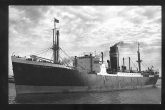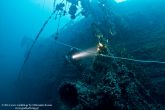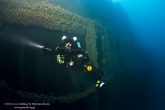Shipwreck S/S Clan Cumming
The Clan Line was founded in 1877 in Liverpool as C. W. Cayzer & Company, trading from the UK to India. The company became Cayzer, Irvine & Company in 1878 when Captain William Irvine joined the firm. In 1881 the Clan Line Association of Steamers was formed and, with an influential Glasgow businessman joining the firm, the company was moved to Glasgow. Clan Line head office was established at 109 Hope Street, Glasgow. New ships were built and managed for the Association by Cayzer Irvine, with Cayzer retaining ownership of the original six Clan ships.In 1890 the name of the company became The Clan Line of Steamers Limited with Cayzer holding majority interest. The company purchased the Persian Gulf Steam Ship Company in 1894 and their fleet of four ships. Fare at this time from Liverpool to Madras or Calcutta was £45 first class and £30 second class.The company became Cayzer, Irvine & Company, Limited, in 1907 and in 1918 the assets of the Scottish Shire Line were acquired. The same year the Houston Line was taken over together with the British and South American Steam Navigation Company, but all three of these companies retained their own system of ship naming, colours and liveries.In 1956 a merger took place between the Clan and Union-Castle groups (including King Line and Bullard King & Company) to form the British & Commonwealth Shipping Limited and many transfers between component companies within the group took place after this date.The South African based subsidiary Springbok Shipping Company was formed in 1959 to operate South African services and several Clan ships were transferred to this new company, which in 1961 became part of Safmarine. Hector Whaling came into the group in 1962.In 1981, the Clan Line ceased trading but Cayzer Irvine managed ships until 1987, including the Stirling Universal for Union-Castle from 1981-1987. When Cayzer sold the British & Commonwealth Shipping Company Cayzer Irvine changed its name to C I Shipping, Limited and managed the Stirling Universal for a further year prior to its sale to Iran in 1988.
In 1941, during WWII, the Central Bank of Turkey ordered this 50 Kurus note from the English printers Bradbury, Wilkinson & Co. Ltd in New Malden, Surrey (a suburb in south-western London).The newly printed lot was shipped on board the British steamer “Clan Cumming”.The “Clan Cumming” arrived at Gibraltar on 06.01.1941 and continued together with several other ships in a well protected convoy toward Malta and Piraeus. On 15.04.1941, German bombers made an attack on the harbor area. The “Clan Cunning” was hit by an air mine near the island of Salamis and sank.
Official No. 165924 Grt 7264 Nrt 3676
463.7 X 63.0 X 29.9 Feet.
18.10.1937 Launched and 1.1938 completed by Greenock Dockyard Co Ltd. Greenock (Yard No 430) for The Clan Line Steamers Ltd. 11.10.1940 damaged by bombing at Liverpool. 19.1.1941 damaged by Torpedo off Piraeus but reached port. 15.4.1941 hit a mine and sank in the Gulf of Athens.
British cargo ship “Clan Cumming”, with two propellers, with Glasgow ship register number 165924, a volume of 7264 gross registered tonnage and 3676 net registered tonnage, a length of 464 feet, constructed in 1938 at the shipyards of Creenock Dockyard Co. Ltd of Greenock in Scotland, owned by Clan Lines Steamsihi Co. The ship was functioning with steam turbines of 1370 nhp. On 15 April 1941, the ship, sailing from Piraeus to Aleksandria with no cargo, crashed into a mine and sank having no victims.
Sources:Christos Ntounis, Wrecks at Greek Seas 1900-1950, Volume A
Internet
The wreck today
The ship is in the sea bottom on its left side in an angle of 90 degrees. Its bow is located towards the north side and its stern at the south side. A big crack was noticed at the stern, over the propellers. It is covered with benthos and there are remainings by fishing tools. The visibility up to 90 meters (right propeller) is very clear despite the wreck’s position. Under this depth and up to 95 meters there are always blur waters that limit the visibility. The maximum depth is 95 meters and the minimum depth is 74 meters. At the side of the bow there is still the firearm that was towards the sky while the ship was sinking. The derricks are located on the main part of the ship in parallel with the sea bottom. The wood construction of the deck of the stern is in an excellent condition despite the fact that 71 years have passed since its sinking.






